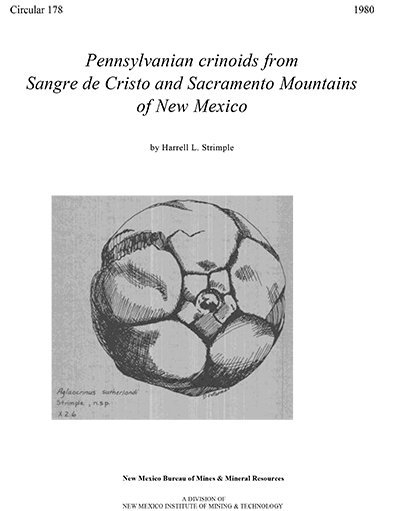
Circular 178—Pennsylvanian crinoids from Sangre De Cristo and Sacramento Mountains of New Mexico
By H. L. Strimple, 1980, 17 pp., 2 tables, 2 figs., 2 plates.

Discusses 12 species representing eight genera of inadunate crinoids reported from Lower and Middle Pennsylvanian strata of New Mexico. Two new species are proposed: Diphuicrinus santafeensis n. sp. and Aglaocrinus sutherlandi n. sp. Crinoids preserved as cups or crowns are seldom found because of the multiplated nature of the endoskeleton which is subject to rapid disarticulation upon demise of the animal unless quickly entombed in a soft matrix. Even when such specimens are preserved, tectonic stresses may distort them beyond recognition. Although the number of specimens is rather small, cups and some crowns are being found and recorded from Pennsylvanian strata of the southwestern and western U.S. The specimens have affinities with some previously known crinoid faunas from the midcontinental U.S. and the southern Appalachian Mountains.
Most of the material in the present study was collected by P. K. Sutherland
and F. H. Harlow in the Sangre de Cristo Mountains of New Mexico. A specimen
was collected by C. C. Branson from near Alamogordo in the Sacramento Mountains;
specimens collected from the same locality by W. M. Furnish, B. Furnish,
C. Strimple, and the author are also included. All specimens are Early or
Middle Pennsylvanian in age.
Twelve species are recognized, although one Paragassizocrinus, one Plaxocrinus, and one Metacromyocrinus are not identified to
species. Seven of the species have been previously described from other
geographic areas. Eight genera are involved, all belonging to the subclass
Inadunata. Locality references for specimens form the Sangre de Cristo Mountains
are those used by Sutherland and Harlow. Detailed information on localities
is given in the locality register.
Although limited in numbers as well as geographic distribution, the material
can be compared stratigraphically with somewhat better known faunas.
Palmerocrinus profundus (Moore and Strimple) is know from the Wapanucka
Formation (Morrowan) of southern Oklahoma and the Quivirrah Formation (Morrowan)
of Utah. Paragassizocrinus caliculus (Moore and Plummer) has been
reported from Bloydian (Morrowan) strata in northeast Oklahoma, northwest
Arkansas, and southern Oklahoma. Diphuicrinus coalensis (Strimple
and Moore) occurs in the Atoka Formation (Atokan) in Coal County, Oklahoma; D. santafeensis n. sp. is closely related to similar species in Atokan
of lower Desmoinesian strata in Oklahoma. Anchicrinus planulatus (Moore
and Strimple) is known from the Bloydian rocks in northeast Oklahoma and
northwest Arkansas. Although considered a discrete species, Algaocrinus
sutherlandi n. sp. has the same general appearance as A. keyti (Strimple
and Moore) from the McCoy Formation of Colorado and other species of the
genus in the Dornick Hills formation (Desmoinesian) of the Ardmore Basin
in southern Oklahoma. Metacromyocrinus sp. shows close affinity with M.
gillumi (Strimple) from the Morrowan of Arkansas and M. holdenvillensis
(Strimple) of the Holdenville Formation (Desmoinesian) of Oklahoma.
$5.00
Buy
Now
Note: availability of this item
is limited!
Also available as a free download.
Download
| File Name | Size | Last Modified |
|---|---|---|
| Circular-178.pdf | 614 KB | 01/11/2021 03:39:13 PM |



